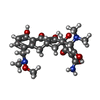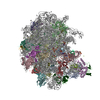+Search query
-Structure paper
| Title | Sarecycline inhibits protein translation in Cutibacterium acnes 70S ribosome using a two-site mechanism. |
|---|---|
| Journal, issue, pages | Nucleic Acids Res, Vol. 51, Issue 6, Page 2915-2930, Year 2023 |
| Publish date | Apr 11, 2023 |
 Authors Authors | Ivan B Lomakin / Swapnil C Devarkar / Shivali Patel / Ayman Grada / Christopher G Bunick /  |
| PubMed Abstract | Acne vulgaris is a chronic disfiguring skin disease affecting ∼1 billion people worldwide, often having persistent negative effects on physical and mental health. The Gram-positive anaerobe, ...Acne vulgaris is a chronic disfiguring skin disease affecting ∼1 billion people worldwide, often having persistent negative effects on physical and mental health. The Gram-positive anaerobe, Cutibacterium acnes is implicated in acne pathogenesis and is, therefore, a main target for antibiotic-based acne therapy. We determined a 2.8-Å resolution structure of the 70S ribosome of Cutibacterium acnes by cryogenic electron microscopy and discovered that sarecycline, a narrow-spectrum antibiotic against Cutibacterium acnes, may inhibit two active sites of this bacterium's ribosome in contrast to the one site detected previously on the model ribosome of Thermus thermophilus. Apart from the canonical binding site at the mRNA decoding center, the second binding site for sarecycline exists at the nascent peptide exit tunnel, reminiscent of the macrolides class of antibiotics. The structure also revealed Cutibacterium acnes-specific features of the ribosomal RNA and proteins. Unlike the ribosome of the Gram-negative bacterium Escherichia coli, Cutibacterium acnes ribosome has two additional proteins, bS22 and bL37, which are also present in the ribosomes of Mycobacterium smegmatis and Mycobacterium tuberculosis. We show that bS22 and bL37 have antimicrobial properties and may be involved in maintaining the healthy homeostasis of the human skin microbiome. |
 External links External links |  Nucleic Acids Res / Nucleic Acids Res /  PubMed:36864821 / PubMed:36864821 /  PubMed Central PubMed Central |
| Methods | EM (single particle) |
| Resolution | 2.66 - 2.95 Å |
| Structure data | EMDB-26959, PDB-8crx: EMDB-27009, PDB-8cvm: EMDB-27011, PDB-8cvo: EMDB-27028, PDB-8cwo: |
| Chemicals |  ChemComp-V7A:  ChemComp-MG:  ChemComp-ZN:  ChemComp-HOH: |
| Source |
|
 Keywords Keywords | ANTIBIOTIC / ribosome / sarecycline / acne |
 Movie
Movie Controller
Controller Structure viewers
Structure viewers About Yorodumi Papers
About Yorodumi Papers











 cutibacterium acnes (bacteria)
cutibacterium acnes (bacteria)